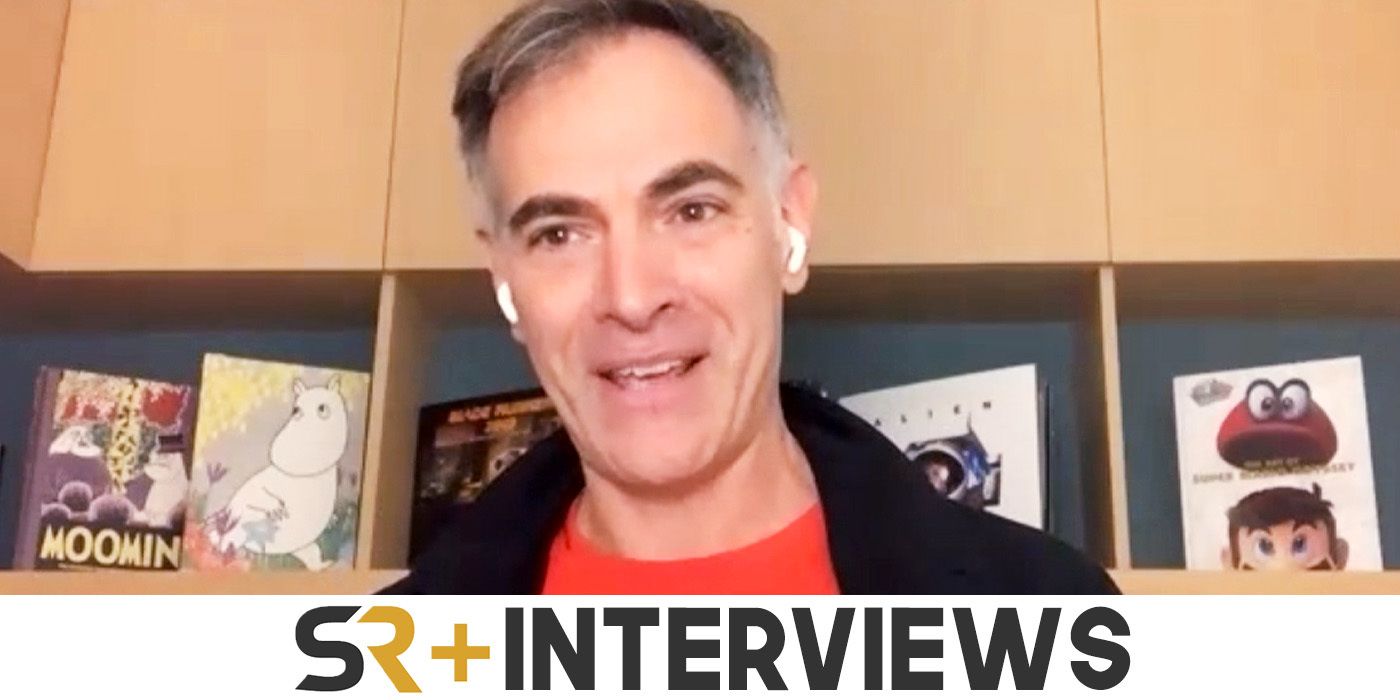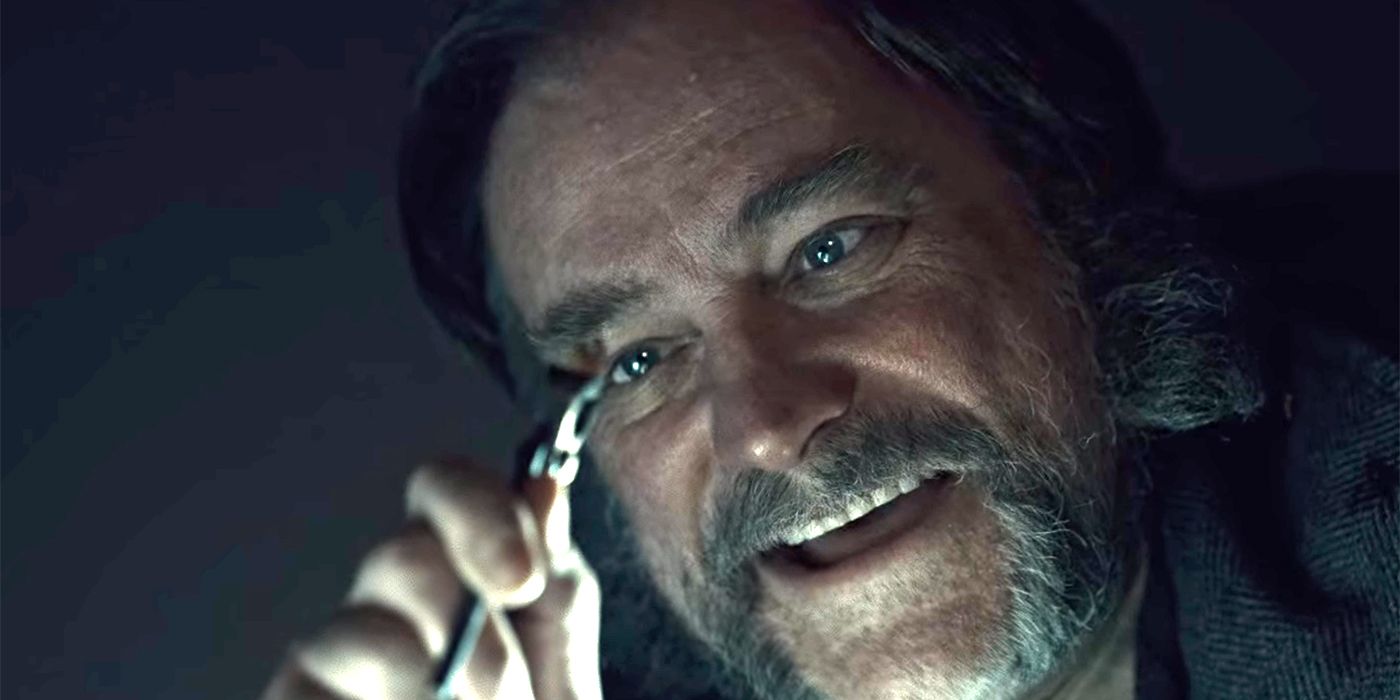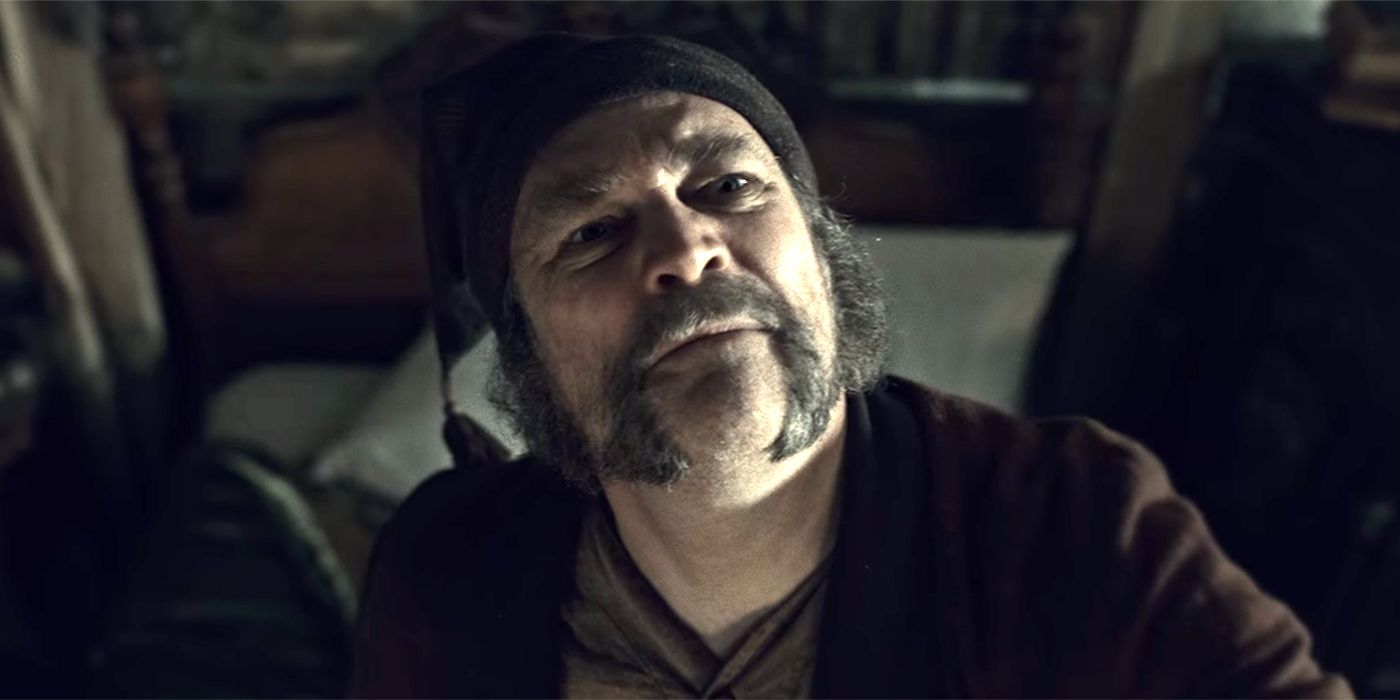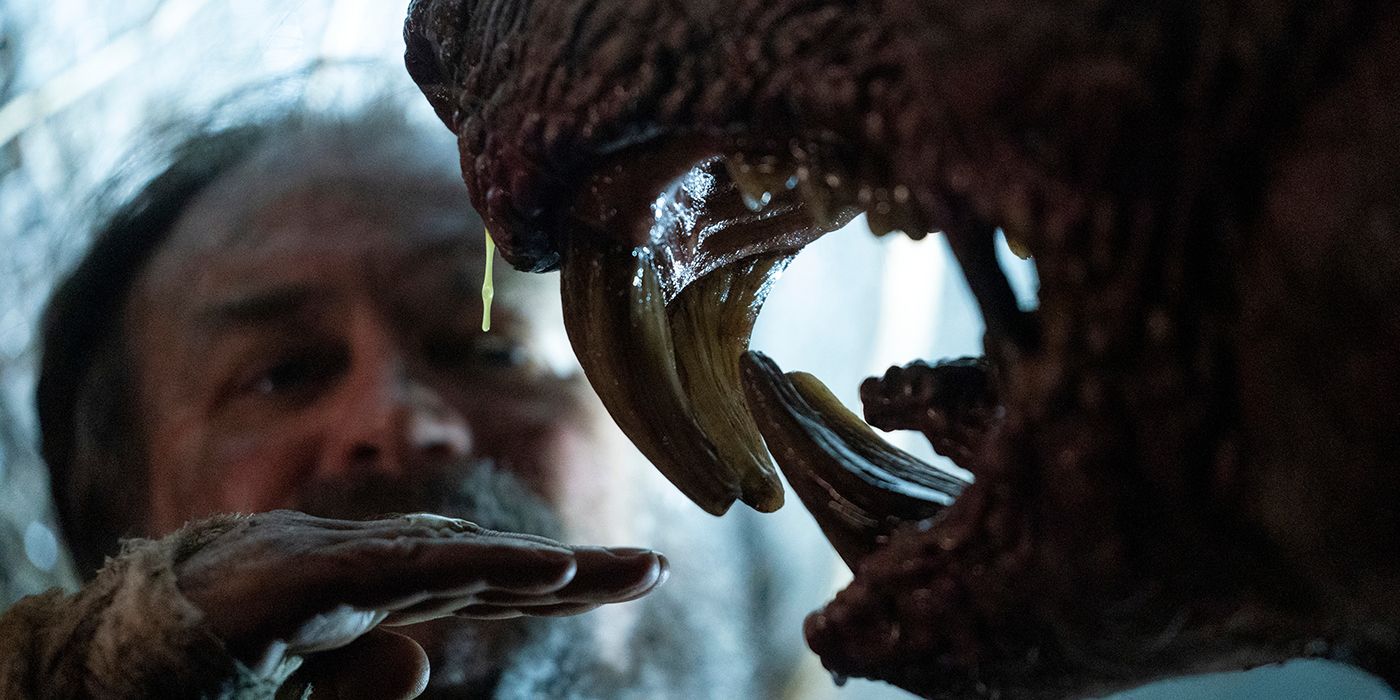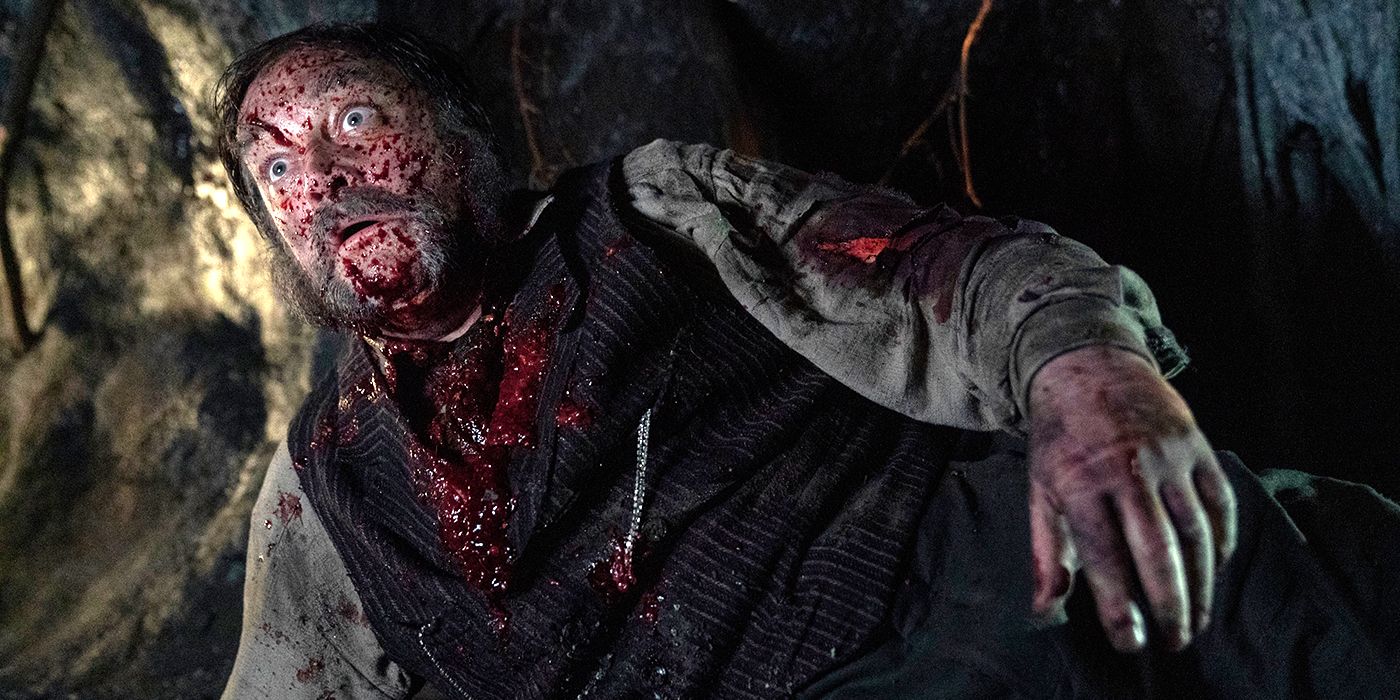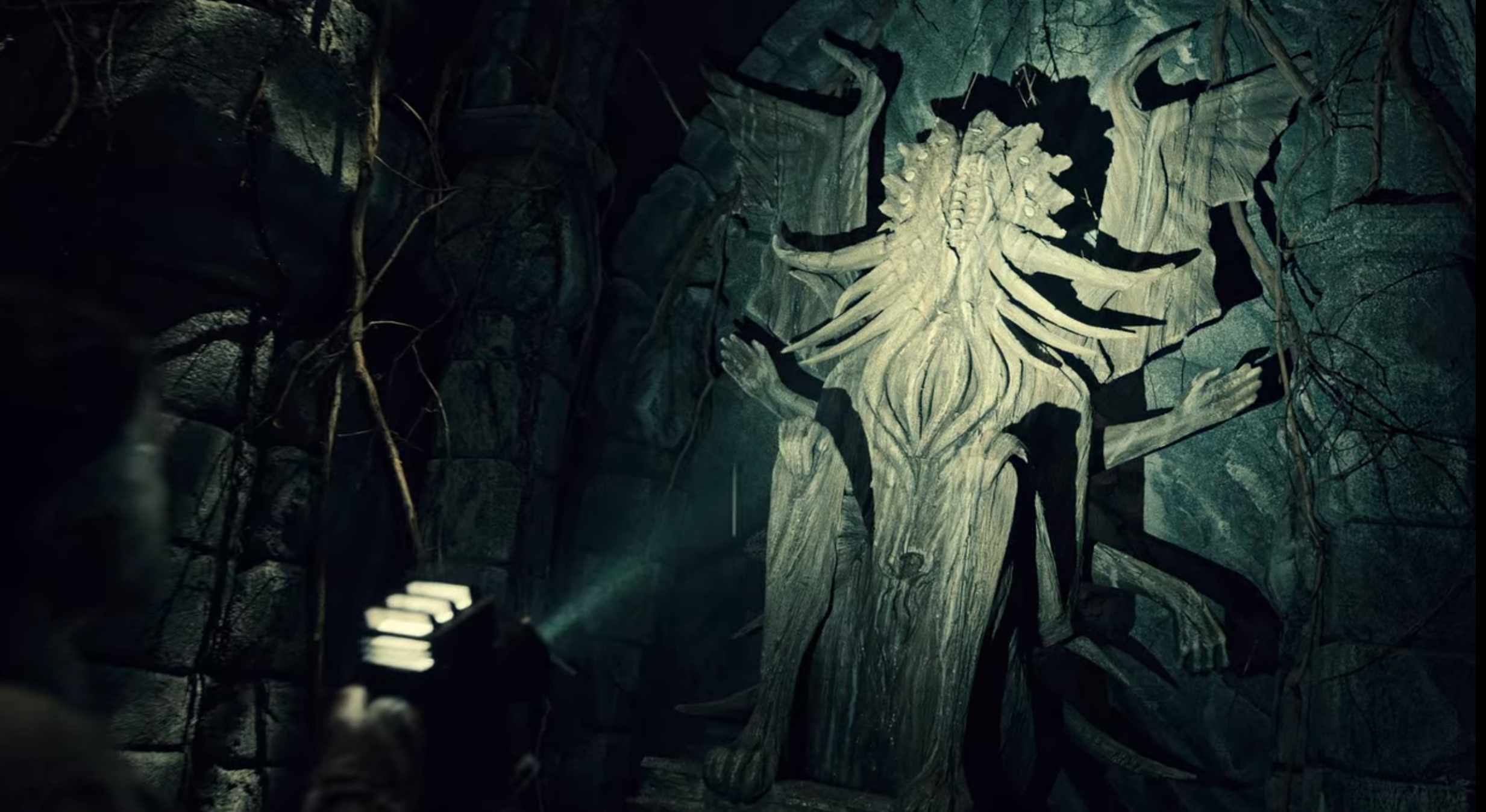Step into some of the most fascinating short horror stories with Guillermo del Toro's Cabinet of Curiosities. The Netflix horror anthology is a collection of adaptations curated by del Toro based on some of his favorite stories, as well as his own original tales.
Del Toro has gathered a roster of well-known, independent filmmakers for the various Cabinet of Curiosities outings, some of whom include The Empty Man's David Prior, The Babadook's Jennifer Kent, and Mandy's Panos Cosmatos. Woven together with unique opening monologues from del Toro himself, the anthology collection is a horror genre fan's delight.
Ahead of the collection's premiere, Screen Rant spoke exclusively with writer-director Vincenzo Natali to discuss Guillermo del Toro's Cabinet of Curiosities, his installment, "Graveyard Rats," writing specifically for his "muse" David Hewlett, and more.
Vincenzo Natali on Cabinet of Curiosities
Screen Rant: I've been a fan of yours for a while now. Just a few nights ago, I rewatched the original Cube, not even thinking about today's interview. Going through the Cabinet of Curiosities yesterday, I know that Guillermo del Toro had handpicked everybody to help bring these stories to life. How did you hear about this project and come to be a part of it?
Vincenzo Natali: Well, I had the good fortune to meet Guillermo many years ago. If you are a geek, and you make a movie, there's a good chance that they'll end up on this festival circuit in Europe and that is really where I got to know Guillermo. Guillermo truly is the great impresario of the fantastic arts, his knowledge is so deep and passionate. When I first met him, I'll never forget it, he put me in a great big bear hug instantly, and said, I love your movie. I thought he was gonna say Cube, because that's sort of what I'm known for, and instead, he said Cypher, which is my second film that not many people know.
It really touched me, and I think that's emblematic of how Guillermo is as a personality. He's kind of a magical character, not unlike one of his creations, he really knows how to connect with people, so I had the good fortune to be connected to him, and had asked him some years later to produce my film Splice, and he was an executive producer on that. Then, over the years, he would call me up on occasion with a project he was about to do, and none of them actually came to fruition until Cabinet of Curiosities, and that's just been a magnificent experience from beginning to end.
Were you familiar with the short story that he wanted you to help bring to life beforehand, or did you learn about it once he came to you?
Vincenzo Natali: I didn't know it at all, there was a menu of stories that he had optioned, and initially, I was chasing a Junji Ito story, if you know him, I'm actually wearing a Junji Ito shirt right now. He's a magnificent Japanese manga, horror manga artist, and there was a story called "Hanging Balloons" that's one of the most outrageous, extraordinary things I've ever read. But, we couldn't get the rights to it, so I went back to his list, and "Graveyard Rats," although I was not familiar with it before, it really spoke to me. It was great, I had just a lovely experience. I wrote it for David Hewlett, my muse, not knowing that I would actually get to cast him.
God love Guillermo and J. Miles Dale, who produced it, they said "Yes," and that was sort of the pattern for the entire production and post-production of the show was just, "Yes, yes, yes." I'm so used to "No, no, no." [Laughs] But, I think they really wanted the directors to make these episodes their movies, and take ownership over them, and creatively invest themselves in the same way they would in one of their own films. Hopefully, the results have proven that to be a good methodology, but for me, it was terrific. I really felt supported and well-financed, it was a really great experience.
I think all of them are mini-movies, and I love that they feel self-contained. I'm sure a short story is easier to translate to an hour-long special in comparison to a feature-length film, but did you find any challenges in harnessing the source material for the runtime that you had?
Vincenzo Natali: No, I partially chose the story, because I could immediately see how you would do it. It has a wonderful ending, which is rare to come across a really great ending, and the story has a fantastic ending, so actually, all I did was I sort of gave it an injection of steroids. It was written in, I believe, the mid-1930s by Henry Kuttner, and it just needed to be brought into the 21st century, in terms of the energy that went into it, and the kind of degree of horror that we were dealing with.
I found it very pleasurable and easy to adapt, and that I also saw, even though it predates EC comics, I saw it as a kind of within that mold, and I have a tremendous affection for those comics, and affection for all of the comics that were later inspired by EC comics, and the artists that work in that space, like Bernie Wrightson. This is very Bernie Wrightson, there's a huge Bernie Wrightson stamp on this. I'm a big fan of his work, he's one of my favorite comic book artists, so yeah, it was really comfortable working on that story.
That's wonderful to hear, and I love that you have that inspiration for it. Did you also turn to those for the look of the film, or more just for the feel of it?
Vincenzo Natali: Yeah, very much for the look. It's a hard thing to translate Bernie Wrightson's work literally, because his power as an illustrator is in exaggeration. But it does kind of give you a template and vibe, and I knew the assignment, I knew as much as this is my movie, I'm also aware that I am working under the umbrella of Guillermo del Toro, and what appeals to him.
I know the story, he told me it was the story that frightened him more than any other that he's read. He read it when he was a kid, and it literally sent him running out of his bedroom and to his parents' bedroom. So, I was sort of working a little bit in that vernacular, but it's kind of in my DNA, too, I grew up on a steady diet of that kind of stuff.
I love the old-style English that we hear throughout it, especially with David. How was it working with him to really hone in that speed, energy, and style?
Vincenzo Natali: Well, I know David so well, because we went to high school together, and he was the first actor I ever worked with. We made super-8 films when we were kids, and he's sort of been my muse for, I don't know want to say how many years. I know him so well as both a friend and as an actor, and I knew that when I wrote this almost grotesquely verbose dialogue for him, he's like one of the only actors who could actually zoom through it, who could actually make it palatable, and fun, because he just speaks so fast, he has so much nervous energy, which is, again, why I was so grateful that we were actually able to cast him.
It's a very florid piece, I was not trying to restrain myself in any way, it was really about taking this concept and the characters and taking it as far as possible. Then, in the case of David, the wonderful thing about him is, no matter how despicable a character he plays, there's just something inherently vulnerable about him, and likable. Even if he's carrying the earring off a dead corpse, or pulling its teeth, out robbing a grave, you just can't help but like him. He's also the kind of actor that you enjoy watching being tortured, as I've consistently done in my films over the years. [Laughs] I think he's the only actor I could put through that kind of actual physical abuse. Because it was really hard, when one of my tasks as a director was to put the audience in David's character's shoes, in Masson's shoes, I wanted the audience to feel like they're stuck in that tunnel with him in that rathole.
That kind of meant we really had to stick the actor and the camera in a rathole, and David was on his hands and knees for days and days on end, and it was literally a back-breaking experience, and he never complained. He had rats crawling over his face, and s----ing on him, and pissing on him, and scratching him, and he never complained. [Laughs] He's just one of the greatest people, and he's also a magical kind of character, so yes, it was just a fabulous time.
Talk about a team player, right?
Vincenzo Natali: Totally a team player, and inspires everyone around him. The other wonderful thing about this is, after a certain point, it's kind of a one-man show. I mean, it's him and a bunch of rats, big and small, and it was really a delight for me to just languish in the cuteness of it all.
Since we're talking about the rathole, and the rats themselves. I love how very practical a lot of the effects are in the latter half of the episode. What was it like finding that balance between CGI and practical effects for all of these rats, and the rathole, and all of those things?
Vincenzo Natali: Well, I know that Guillermo is a great proponent of makeup effects, as he had one time been a makeup effects artist early on in his career. Point in fact, I also aspired to be a makeup effects artist, although I didn't go as far as he did, in terms of actually having a shot. But I, certainly as a teenager, did horrible things to myself and my friends with plaster of Paris, and latex and dental stone. So, we both have a great appreciation for that art form, and I know going in, Guillermo, that was one of the things he was going to do, is build monsters. In fact, he probably did the series just so he could get to design and build a lot of monsters, I think that was one of the prime motivators.
To that end, we had this amazing studio called Spectral Motion that built our creatures and just did exquisite work, and really provided us with the first animatronic puppet that's ever worked for me. It's a spoiler, but there's a giant rat down there we call the Queen Rat, and that is entirely physical, barring a couple of shots, but it is a beautiful puppet, it performed beautifully. Then, of course, the benefit of that is you have a real thing for your actor to respond to, as opposed to looking at a grip stand with a tennis ball, which is what you get when you have a digital creature. There was an eight-foot rat sitting there with David, and it was really moving, and it was truly convincing. So, it's great for David, for the performer, and it's great for me as a director, because in real time, I could direct the puppeteers.
It's like having another actor on set, and that's sort of how I treat it, so that was just magical to behold. But we also had great visual effects that was headed by Dennis Berardi, who does a lot of Guillermo's work, who did a lot of the rat creation, these life-size, "real" rats are largely digital, and I don't think you would necessarily know, because Dennis' work is so excellent.
Yeah, it was definitely hard to tell on a lot of those shots which rats were CGI and which ones were real, they were really well done. One other thing I love about the series as a whole is Guillermo's openings where he gives the little monologue and then introduces everybody, and I love that he has little statues of the directors. When did he tell you that that was his idea for the openings, and what was your first reaction when you heard that?
Vincenzo Natali: Well, I didn't know about that until much later, after we had wrapped shooting, and it's almost embarrassing how much attention he languishes on the directors of these episodes. I think it speaks volumes about Guillermo that he's somewhat mimicking what Alfred Hitchcock did for Alfred Hitchcock Presents, his TV series, but I don't believe Alfred Hitchcock ever mentioned anyone that directed one of those episodes. Guillermo has made it his mission to promote the directors, and I just think that's so touching and humbling, let alone to have a statue. That's never gonna happen again, for me, so it was really lovely.
As I say, he's a magical kind of guy, very special, I think more than magical, he's important. Even though English is not his first language, he frequently speaks in English, and I think he's the most elegant, or eloquent, proponent of the cinema fantastique. I think he really has played a role in terms of elevating its position in the popular conversation, and in our culture, as something that is not just trash or mindless entertainment. He understands and appreciates the deep cultural value that a lot of that work represents. So, I think beyond just being a great filmmaker, I think that he has really contributed.
I couldn't agree more, whether he's producing or directing, Guillermo is just going to go down in history as one of the best. What was it like when you heard who else was going to be a part of this? Because there are so many other phenomenal filmmakers alongside yourself that are a part of this anthology.
Vincenzo Natali: Well, it just makes me feel good. Listen, it's hard out there for anybody to make movies these days, and this is eight movies. They are a little bit on the short side, but they're movies, and each one was treated like its own separate film, and to share the company with all those filmmakers is just tremendously flattering for me. It's exciting, because I want to see them, I haven't been privy to any of the episodes, I've heard good things about them, but I'm dying to see them. Like, Panos Cosmatos is a friend of mine and fan of my work, I saw his set while I was shooting, and it's incredible. [Chuckles] I cannot wait to see his, among all the others.
Panos' is incredible, I will tell you that now. Before I let you go, I have just one final question, I know that at one point they were working on a remake of Cube, and I don't think I read that you were involved in it, but have you heard any updates on how that might be going?
Vincenzo Natali: No, I only hear through my younger filmmaker friends who have to go and pitch for it. [Laughs] You know, someone calls me up and says, "Hey, I just pitched for Cube." But, I really have nothing to do with it, I don't own the rights, and it's with Lionsgate, and they have their plans. I think, if I had to guess, the success of Squid Game sort of reinvigorated their interest. I know they were trying to remake it a number of years ago with John Spaihts, and another director.
For whatever reason, that didn't come to fruition, and then it seemed to sort of pick up again recently, and I think it's maybe because there's a little bit of shared DNA with Squid Game, and that sounded exciting to them. But I don't know. Always a mystery to me, it's nice, though, it's like you make these things, they're like your kids. They go off, and they leave you, and, these movies, they have their own lives. It's nice when they go off and do something, and you see that, dare I say, 25 years later, this thing is still sort of out there doing stuff independently of me.
About Guillermo del Toro's Cabinet of Curiosities
In CABINET OF CURIOSITIES, acclaimed Academy Award-winning filmmaker and creator, executive producer and co-showrunner Guillermo del Toro has curated a collection of unprecedented and genre-defining stories meant to challenge our traditional notions of horror. From macabre to magical, gothic to grotesque or classically creepy, these eight equally sophisticated and sinister tales (including two original stories by del Toro) are brought to life by a team of writers and directors personally chosen by del Toro.
GUILLERMO DEL TORO’S CABINET OF CURIOSITIES is created and executive produced by Guillermo del Toro; executive produced by Academy Award winner J. Miles Dale (The Shape of Water; Sex/Life), who also serves as co-showrunner; and executive produced by Gary Ungar. Regina Corrado serves as co-executive producer. Del Toro also serves as host.
Check out our other Cabinet of Curiosities interviews here:
Guillermo del Toro's Cabinet of Curiosities is now streaming on Netflix.

